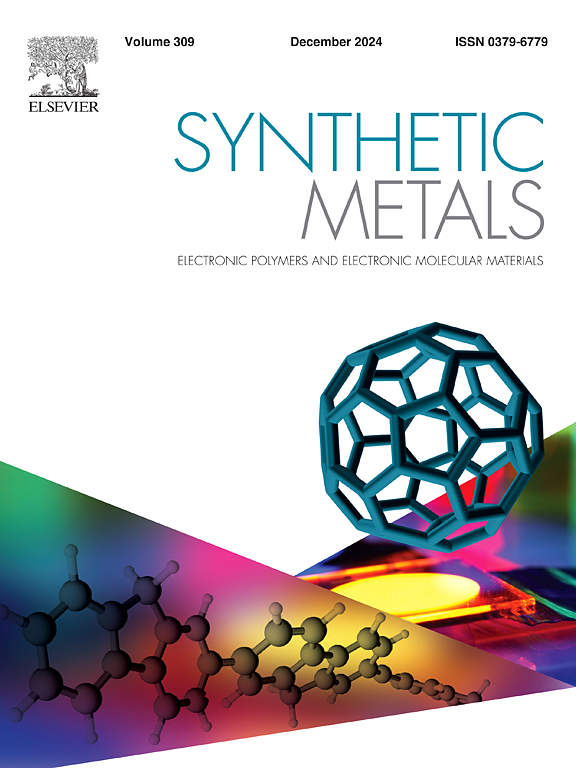聚吡咯纳米结构形态对溶液纺PU复合纤维可纺性和导电性的影响
IF 4.6
3区 材料科学
Q2 MATERIALS SCIENCE, MULTIDISCIPLINARY
引用次数: 0
摘要
近年来,针对各种应用的可穿戴电子纺织品的研究有了显著的增长。成功集成电子元件的重要要求之一是开发柔性和可拉伸的导电纤维。在文献中,具有高导电性的纤维通常依赖于高负载的纳米金属或碳基填料。我们采用湿法纺丝的方法,开发了聚氨酯(PU)和聚吡咯(PPy)纳米结构的可拉伸复合纤维。采用聚吡咯纳米颗粒(PPyNPs)和聚吡咯纳米管(PPyNTs)作为导电填料,浓度范围为2 ~ 12 wt%。这些纳米结构的纵横比深刻地影响了PU/DMF纺丝掺杂的流变学,与PPyNPs相比,PPyNTs具有更高的剪切减薄行为和更好的粘弹性,有利于连续纤维的形成。流变学差异转化为可纺性和纤维性能的改善。在与PPyNPs用量相同的情况下,PPyNTs具有更好的可纺性、增强的机械性能和显著提高的导电性。含有12 wt% PPyNTs的复合纤维的电导率为0.21 S/cm,而含有12 wt% PPyNPs的复合纤维的电导率为8.6E-8 S/cm。此外,纤维在反复变形中表现出很高的稳定性。这种纤维可能会在可穿戴电子纺织品中用作连接线。本文章由计算机程序翻译,如有差异,请以英文原文为准。
Effect of morphology of poly(pyrrole) nanostructures on the spinnability and conductivity of solution-spun PU composite fibers for E-Textiles
In recent years, there has been significant growth in wearable e-textiles research for various applications. One of the important requirements for successfully integrating electronic components is the development of flexible and stretchable conducting fibers. In the literature, fibers with high conductivity often rely on high loadings of nano-metallic or carbon-based fillers. We have developed stretchable composite fibers using polyurethane (PU) and poly(pyrrole) (PPy) nanostructures by wet spinning. Poly(pyrrole) nanoparticles (PPyNPs) and poly(pyrrole) nanotubes (PPyNTs) were employed as conductive fillers in concentrations ranging from 2 to 12 wt%. The aspect ratio of these nanostructures profoundly affected the rheology of the PU/DMF spinning dopes, with PPyNTs inducing higher shear-thinning behavior and better viscoelastic properties, compared to PPyNPs, favoring continuous fiber formation. The rheological differences translated into improved spinnability and fiber properties. With the same amounts as PPyNPs, the PPyNTs exhibited better spinnability, enhanced mechanical properties, and significantly greater electrical conductivities. The composite fibers with 12 wt% of PPyNTs showed a high conductivity of 0.21 S/cm compared to 8.6E-8 S/cm with 12 wt% of PPyNPs. Further, the fibers showed high stability in repeated deformations. The fibers may find applications as connecting wires in wearable e-textiles.
求助全文
通过发布文献求助,成功后即可免费获取论文全文。
去求助
来源期刊

Synthetic Metals
工程技术-材料科学:综合
CiteScore
8.30
自引率
4.50%
发文量
189
审稿时长
33 days
期刊介绍:
This journal is an international medium for the rapid publication of original research papers, short communications and subject reviews dealing with research on and applications of electronic polymers and electronic molecular materials including novel carbon architectures. These functional materials have the properties of metals, semiconductors or magnets and are distinguishable from elemental and alloy/binary metals, semiconductors and magnets.
 求助内容:
求助内容: 应助结果提醒方式:
应助结果提醒方式:


